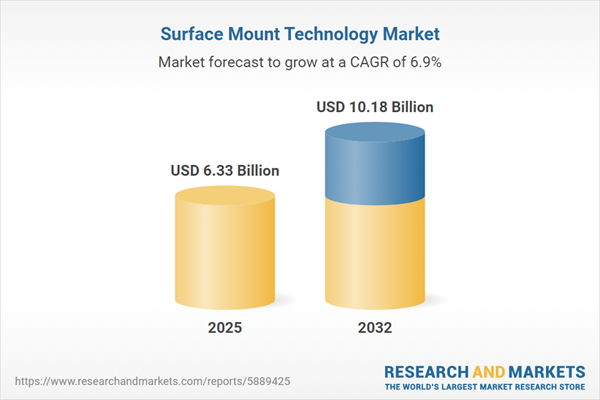Speak directly to the analyst to clarify any post sales queries you may have.
Surface mount technology plays a fundamental role in the advancement of global electronics manufacturing, offering scalable solutions for increased miniaturization, enhanced operational throughput, and broad application flexibility. Senior leaders in the field routinely leverage this technology to address evolving demands for reliability and adaptability across multiple industry sectors.
Market Snapshot: Surface Mount Technology Market Overview
The Surface Mount Technology Market grew from USD 5.95 billion in 2024 to USD 6.33 billion in 2025. It is expected to continue growing at a CAGR of 6.92%, reaching USD 10.18 billion by 2032. Firms invest in surface mount technology to drive operational efficiency, manage increasing component complexity, and support integrated workflows that address digitalization, automation, and sustainability. This momentum is shaping procurement, deployment, and innovation strategies for organizations worldwide.
Scope & Segmentation of the Surface Mount Technology Market
- Product: Cleaning equipment, inspection equipment, placement equipment, repair & rework equipment, screen printing equipment, soldering equipment
- Component: Active components (capacitors, inductors, resistors), passive components (diodes, integrated circuits, transistors)
- Assembly Type: Fully automated assembly, manual assembly, semi-automated assembly
- Application: Aerospace & defense, automotive (driver assistance systems, infotainment systems), consumer electronics (audio & video systems, home appliances, mobile phones, personal computers, storage devices), healthcare (consumer medical devices, medical imaging equipment), industrial (industrial automation & motion control, mechatronics & robotics, photovoltaic systems, power electronics), IT & telecommunication (networking devices, telecom equipment)
- Region: Americas (United States, Canada, Mexico, Brazil, Argentina, Chile, Colombia, Peru), Europe, Middle East & Africa (United Kingdom, Germany, France, Russia, Italy, Spain, Netherlands, Sweden, Poland, Switzerland, United Arab Emirates, Saudi Arabia, Qatar, Turkey, Israel, South Africa, Nigeria, Egypt, Kenya), Asia-Pacific (China, India, Japan, Australia, South Korea, Indonesia, Thailand, Malaysia, Singapore, Taiwan)
- Companies Analyzed: AEMtec GmbH, Aimtron Corporation, American Products, ASMPT Singapore, Assel, Cirexx International, Electronic Manufacturing Services Group, ELIM Electronics, EMS Solutions, FUJI Corporation, Heller Industries, Indium Corporation, Interconics, Juki Corporation, Kasdon Electronics, Kurtz Holding, KUS USA, Mycronic AB, Nordson Corporation, Panasonic Holdings, PCBCART, Seika Corporation, Solid Semecs B.V., Star Engineering, Weidmüller Interface, Yamaha Motor, Zhejiang NeoDen Technology
Key Takeaways for Senior Decision-Makers
- Surface mount technology adoption supports robust miniaturization and complex assembly requirements, positioning enterprises to respond to evolving design trends and end-user demands.
- Next-generation solutions such as AI-enabled inspection and modular placement systems are strengthening process control, reducing downtime, and expanding operational capacity.
- Sustainability initiatives drive adoption of environmentally conscious cleaning, soldering, and closed-loop manufacturing workflows, aligning processes with emerging regulatory requirements and corporate ESG goals.
- Regional supply chain alignment, especially the qualification of domestic and nearshore suppliers, enables organizations to navigate shifts in trade policy and achieve greater production continuity.
- Close collaboration among equipment providers, component manufacturers, and end-users accelerates product innovation and allows for rapid market adaptation across sectors including automotive, healthcare, and telecommunications.
Assessing Tariff Impacts on the Surface Mount Technology Market
Recent tariff rounds targeting imported components and electronics equipment have led to higher production costs and prompted a realignment of supplier relationships. Organizations are countering these challenges by diversifying vendor portfolios, qualifying regional sources, and adapting inventory and repair strategies. Broader impacts include an increased focus on supplier collaboration and long-term sourcing agreements that balance cost, quality, and regulatory compliance.
Methodology & Data Sources
This analysis draws on primary interviews with industry experts and decision-makers, combined with secondary data from technical journals and patent filings. Data triangulation and validation workshops ensure accuracy and rigor, while process flow analysis and targeted surveys reveal best practices and emerging trends.
Why This Report Matters
- Enables informed strategy development through clear comparisons across market segments, technologies, and regions.
- Supports risk mitigation by assessing the impact of regulatory changes and supply chain disruptions on operational continuity.
- Guides resource allocation for research, process innovation, and competitive benchmarking in the evolving electronics landscape.
Conclusion
Surface mount technology continues to redefine electronics manufacturing, bringing new opportunities for efficiency and resilience. Business leaders leveraging these insights will be positioned to navigate market disruptions and drive targeted growth.
Additional Product Information:
- Purchase of this report includes 1 year online access with quarterly updates.
- This report can be updated on request. Please contact our Customer Experience team using the Ask a Question widget on our website.
Table of Contents
3. Executive Summary
4. Market Overview
7. Cumulative Impact of Artificial Intelligence 2025
Companies Mentioned
The companies profiled in this Surface Mount Technology market report include:- AEMtec GmbH
- Aimtron Corporation
- American Products, Inc.
- ASMPT Singapore Pte. Ltd.
- Assel Sp.z .o.o.
- Cirexx International, Inc.
- Electronic Manufacturing Services Group, Inc.
- ELIM Electronics Corp.
- EMS Solutions
- FUJI Corporation
- Heller Industries, Inc.
- Indium Corporation
- Interconics Limited
- Juki Corporation
- Kasdon Electronics Ltd.
- Kurtz Holding GmbH & Co. Beteiligungs KG
- KUS USA, INC.
- Mycronic AB
- Nordson Corporation
- Panasonic Holdings Corporation
- PCBCART
- Seika Corporation
- Solid Semecs B.V. by Sero GmbH
- Star Engineering, Inc.
- Weidmüller Interface GmbH & Co. KG
- Yamaha Motor Co., Ltd.
- Zhejiang NeoDen Technology Co.,Ltd.
Table Information
| Report Attribute | Details |
|---|---|
| No. of Pages | 180 |
| Published | November 2025 |
| Forecast Period | 2025 - 2032 |
| Estimated Market Value ( USD | $ 6.33 Billion |
| Forecasted Market Value ( USD | $ 10.18 Billion |
| Compound Annual Growth Rate | 6.9% |
| Regions Covered | Global |
| No. of Companies Mentioned | 28 |









